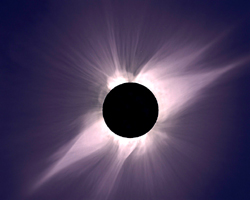
Sun-Earth Day Presents: Eclipse, In a Different Light
E-CLIPS
Two Eclipse StoriesBy Charles N. Fulco

"This 1991 photograph captures the brief moment of totality when the Sun's faint corona is most easily observed. It is made up of several photographs from cameras with different settings that were later combined into one image." Credit: Steve Albers, Dennis di Cicco, and Gary Emerson.
After several attempts to view a total solar eclipse (including just missing totality from my backyard in N.Y. in 1970), I finally decided I wasn't going to let the longest totality until 2132 get away, so I asked my mother and sister if they would accompany me to the path of the moon’s shadow the following July. Much to my surprise, they both said “yes” and I immediately began planning the trek. Choosing the location almost seemed too easy to be true—just south of Mazatlan, Mexico, there would be good weather prospects, a clear view of the moon’s approaching shadow over the ocean, the sun at the zenith, and 6-1/2 minutes of totality—pinch me, I’m dreaming!
And sure enough, almost a year later, there we were at that beach on the Pacific, and the call of “first contact” was heard. I had seen numerous first contacts before, but never one which would climax with totality. From that moment on, it was pure exhilaration and anticipation, taking in all the sights and events I’d read so much about—there was the sunlight dimming into an eerie silver-grey; the thatched roof of a patio shelter spraying images of thinning crescents all over our shirts; my sister holding a lock of her hair waist-high and seeing its shadow incredibly sharp on the blanket below. Then came the real goose bumps—the sun becoming an impossibly thin sliver in a high blue sky, and all of us knowing with five minutes left and only wispy, high cirrus clouds around the quickly diminishing sun that we’d see this thing after all!
As much as I’d planned on how I’d watch totality approach, it all went to hell within secondsl. As the final moments approached, I fumbled with my camera, and as I finally wrestled the neutral density filter off, I first caught sight of the corona through my viewfinder—14 years on, and I still remember all the intensely beautiful details which made up those 6-1/2 minutes: lightning inside the faintly-lit clouds along the horizon, animals going to roost, the sun looking like a tiny black dot punched out of the zenith sky, the fire-pink prominences which suddenly appeared alongside the moon’s edge, and of course the ethereal corona. The crowd went from cheering at the onset of totality to a hushed silence midway through, with only the sound of the surf and clicking cameras amid the ghostly light.
Thinking back, there is so much I don’t remember about those precious minutes. I worked the camera too much, I guess. But I learned my lesson—in 1999 I caught the moon’s shadow again, and this time I soaked the entire 2 minutes and 4 seconds in. I burned the image of a very large-looking sun and corona into my subconsciousness with little regard for the camera. My mother, sister enjoyed this totality very much as well, and appreciated the differences between the two events, including the fact that we were wedged into a small plaza in the old part of Salzburg, Austria amid unaware tourists—quite a contrast from being with scientists on a secluded beach in Mexico.
In retrospect, we loved each eclipse for different reasons, but nothing will ever compare to those 6-1/2 minutes on July 11, 1991.
I guess you never forget your first time.
RELATED SITES
E-Clips
CLIPS
Eclipse Fact
Eclipse shadows travel at 1,100 miles per hour at the equator and up to 5,000 miles per hour near the poles.

